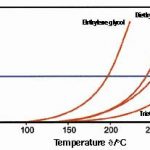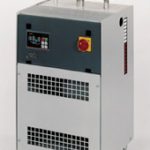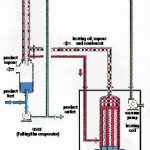In chemical process development small miniplants are increasingly replacing large pilot plants. Evaporation thermostats are often used as heat generators to study chemical engineering processes. The flexible, complete system considerably facilitates their application.
Dr. Markus Hadley, Dr. Ludwig Deibele, Reinhold Jung and Heinrich E. Steude
Computer-aided simulations of new production processes are only sufficient to ensure a functionally reliable design of technical plants in exceptional cases. The required data, for example information about quantities and thermal balances, the accumulation of by-products, corrosion and fouling, often has to be obtained in pilot plants, anticipating every single process step with real products on a smaller scale.
In the recent past, very large, expensive pilot plants have almost disappeared from use; they are increasingly being replaced by miniplants. These are small, modular experimental units, which are for the most part made of glass and designed for flow rates between 0.1 and 10 l/h. The economic advantages are obvious: while the average experimental period for a pilot plant is about three years (including planning, approval and erection time), it is only one year for a miniplant. The costs of a plant can be reduced by one decade. Moreover, the investigated processes can be modified quickly and at relatively little expense.
Tough demands set for the test range
In order to enable the process scale-up, in other words to apply the data obtained in laboratory trials to technical scales, very tough demands have to be satisfied by the trial arrangement and the apparatus which is used. This is particularly valid when modelling technical fluid processes, such as those used for thermal separation in distillation columns. The column temperatures, for example, have a considerable influence on the quality of the products. Local overheating in evaporators that are electrically heated via cartridge heaters can damage sensitive products and falsify information about by-product accumulation. The solution to this problem is evaporation thermostats, which heat the load with the vapour of a high-boiling, organic fluid (heat transfer medium). A high heat flow density can be achieved in this way. If the heat transfer is good, the temperature difference between the product and the heating medium can be kept low. In addition, compared to other heat sources, the heating medium temperature has no gradient along the heating surface.
General functional principle
Evaporation thermostats heat indirectly via the vapour of a heat transfer medium. It is a well-known fact that the vapour pressure of a liquid is directly linked to the temperature (Fig. 1). The heating medium temperature is adjusted simply by varying the operating pressure, which is usually a slight vacuum between 100 and 1000 mbar. The amount of the transported thermal energy depends on the amount of vapour that can circulate in-side the thermostat.
The required amount of vapour is provided via a separately operated evaporator. When the vapours arrive at the heat transfer sur-face, they condense due to the temperature gradient which is formed; during this process, the condensation heat is delivered to the heat transfer surface. Finally, the condensate is fed back into the evaporation thermostat. Only the amount of thermal energy that is actually needed for the process is withdrawn from the heating medium by the load – at a constant temperature. The amount of heat transfer medium inside the evaporation thermostat and the pipes (hold-up) is comparatively low. The system thus reacts considerably faster than liquid-operated thermostats. The low filling quantity has safety advantages as well. Since absolute pressures within the operating range of approximately 100 to 1000 mbar are easily and exactly adjustable, the operating tempera-tures of evaporation thermostats can be accurately adjusted to a fraction of a degree centigrade. Even the slightest driving temperature differences between the heating medium and the heated medium can there-fore be realised.
Heating medium
In industrial practice, water vapour is still used as the heat transfer medium in most cases. Nevertheless, high temperatures – if required – can only be provided under high pressure. In order to guarantee a temperature of 315 °C, for example, a pressure of 110 bar has to be maintained. Such pressures, how-ever, lead to a considerable mechanical strain on the apparatus and the piping systems. This fact to a large extent excludes water vapour from being used as a heat transfer medium in laboratories with their glass apparatus.
Organic liquids such as glycols and hydrocarbons or heating oils such as diphenyl-diphenyloxide are one solution. Their high boiling points can guarantee high heating medium temperatures even at low pressure. Moreover, they can be used for processes in which contact with water from the heating or cooling system would be a considerable potential danger. The cross-section of the piping of the evaporation thermostats has to be adapted in order to use these organic heat transfer media, however. The lower evaporation enthalpies, the higher molecular weights and the lower operating pressures – in comparison to water – have to be considered in this connection.
Pressureless operation
Every heat transfer medium has its ideal range of application when the vapour pres-sure curve is neither too flat nor rises too steeply, so that the system must react to a change in pressure with a corresponding change of vapour temperature. In the case of diphenyl-diphenyloxide, temperature ranges of 150 and 250 °C at a vacuum of approximately 100 to 900 mbar can be achieved. This means that systems operating with diphenyl-diphenyloxide do not fall under the German Pressure Vessel Code and can thus be equipped with vessels with the minimum wall thickness; alternatively, glass units can be used.
All-round system
The excellent performance of the evaporation thermostats has in the past been offset by their very expensive assembly. For pilot trials in miniplant units they have had to be redesigned, put together from glass components and re-tested every single time. For this reason Bayer AG, Leverkusen’s Technical Development Division, Department of Fluid Process Engineering, decided to develop an all-round evaporation thermostat – the vacuum steam heating system – as part of the Vacutherm range (Fig. 2) for a wide range of applications in co-operation with gwk Gesellschaft Wärme Kältetechnik mbH. The compact systems are completely assembled and ready for immediate use. They are ideal for laboratory-scale process development (Fig. 3).
The main component of the above-mentioned system is an electrically heated evaporator which evaporates the different organic heating media according to the required temperature. The user is allowed to directly preset the desired temperature via an operating plant. It is not necessary to know the vapour pressure curve; the internal pressure which corresponds to the temperature is preset via an electronic control unit, which regulates the required temperature accordingly. If the heat transfer medium deviates from the theoretical vapour pressure as a result of the onset of decomposition or contamination, the pressure in the system will be automatically reactivated.
Regulation cycle saves resources
When the vacuum steam heating systems were developed great importance was attached to saving resources. The vacuum pump, which ensures the required pressure, only works when a change in pressure is needed. An internal condenser which has been used to condense the remaining vapour in conventional thermostats may have been with-drawn, for example. The electronic control unit ensures that the electrical heater constantly produces as much vapour as the amount of heat which is required by the load. Cooling with tap-water to withdraw the energy surplus is no longer necessary. The system merely needs a voltage supply in order to operate. The vacuum steam heating systems in the Vacutherm range are manufactured with different heating capacities up to 60 kW. Heating capacities of 6 to 12 kW are normally used for the miniplant field. The investment in this compact system is soon re-covered due to the economies achieved on expenditure for personnel and materials.
gwk
Fax: ++49/2359/6 65 51 56
Further information cpp-249
Unsere Webinar-Empfehlung
Die Websession „Wasserstoff in der Chemie – Anlagen, Komponenten, Dienstleistungen“ (hier als Webcast abrufbar) zeigt technische Lösungen auf, die die Herstellung und Handhabung von Wasserstoff in der chemischen Industrie sicher machen und wirtschaftlich gestalten.
Ob effizienter…
Teilen:













